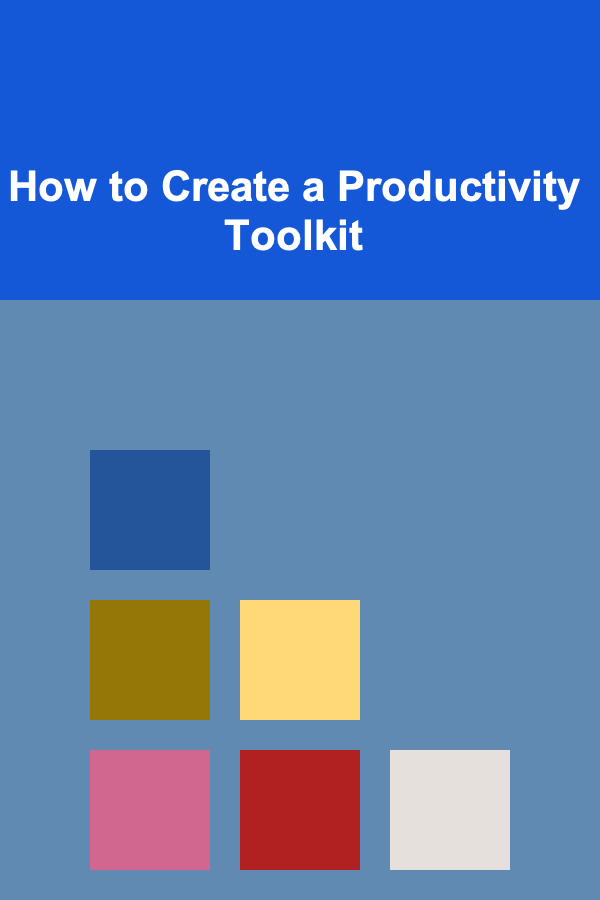
How to Create a Productivity Toolkit
ebook include PDF & Audio bundle (Micro Guide)
$12.99$7.99
Limited Time Offer! Order within the next:

In the age of constant distractions and information overload, mastering productivity is more important than ever. Whether you're working in an office, studying, managing a team, or working from home, productivity is essential to achieving your goals and staying on top of your responsibilities. One of the most effective ways to enhance your productivity is by creating a tailored productivity toolkit---a combination of tools, techniques, and strategies that help you stay organized, focused, and efficient.
A productivity toolkit is not just a list of apps or gadgets. It's a holistic approach that includes your mindset, habits, environment, and tools you use daily. In this guide, we'll explore how to create a personalized productivity toolkit that works for you, from selecting the right tools to building a productive routine. By the end, you'll have a comprehensive toolkit that can boost your productivity and help you accomplish more with less effort.
Assess Your Current Productivity
Before you dive into building a productivity toolkit, it's essential to assess your current productivity. Understanding where you stand will give you a clearer picture of the areas where you need improvement. Take some time to reflect on the following questions:
- What are your most significant productivity challenges? Are you easily distracted? Do you struggle with time management or procrastination? Identifying the root causes of your productivity issues will help you select the right tools to address them.
- What are your goals? Understanding your long-term and short-term objectives will guide the creation of your toolkit. For example, if you're looking to manage a team, your toolkit may focus on collaboration tools, while someone focused on solo work may benefit from time-management tools.
- What tools do you currently use? Take inventory of the tools, apps, and strategies you're already using. Which ones are working? Which ones are hindering your progress? This reflection will help you identify gaps and opportunities for improvement.
Once you have a clearer sense of where you stand, you can begin building a toolkit that will address your specific needs and challenges.
Mindset: The Foundation of Productivity
Productivity doesn't start with tools; it starts with the right mindset. Without the right attitude, even the most sophisticated tools will fall short. A productive mindset helps you stay focused, prioritize effectively, and overcome obstacles. Here are some mindset shifts you can make to lay the foundation for a successful productivity toolkit:
Cultivate Focus and Discipline
Focus is the cornerstone of productivity. In an era of constant distractions---such as social media, emails, and notifications---being able to maintain concentration is crucial. Practicing mindfulness or other focus-enhancing techniques can help you build discipline over time. Techniques such as the Pomodoro Technique, which encourages focused work periods followed by short breaks, can help maintain high levels of concentration.
Adopt a Growth Mindset
A growth mindset is the belief that abilities and intelligence can be developed through hard work, learning, and perseverance. Adopting this mindset will help you stay motivated even when productivity dips. It fosters a willingness to learn from failures and continuously improve your workflow, which is essential when using productivity tools and refining your routines.
Set Clear Goals and Priorities
Being clear about your goals and prioritizing them effectively is key to using your time wisely. Break down large goals into smaller, actionable tasks and focus on what matters most. By aligning your productivity toolkit with your goals, you ensure that every tool you use contributes to achieving these objectives. The Eisenhower Matrix, which divides tasks into urgent, important, not urgent, and not important categories, is an excellent framework to prioritize effectively.
Organizational Tools: Creating Structure in Your Day
Once you have the right mindset, it's time to incorporate tools that help you stay organized. An organized workflow ensures that you can keep track of your tasks, deadlines, and projects, which is essential to staying productive.
Digital Calendars
Calendars are one of the simplest and most effective tools to stay organized. Digital calendars like Google Calendar or Outlook allow you to schedule meetings, reminders, and personal appointments in one place. They also provide features like setting notifications, sharing schedules, and syncing across devices, which helps you stay on track.
To optimize your calendar usage, try adopting time blocking---a method where you allocate specific time blocks for particular tasks throughout the day. This approach ensures that you're working on the right task at the right time, minimizing distractions and improving focus.
Task Management Apps
Task management apps are essential tools for tracking your to-do lists and keeping your projects organized. Popular apps like Todoist , Trello , or Asana help you break down complex projects into manageable tasks and set deadlines. These apps allow you to create task lists, set priorities, and track progress. Additionally, they often feature collaboration tools, which are helpful if you're working with a team.
You can also use a technique called the Getting Things Done (GTD) method, which helps you break tasks down into actionable steps and ensures that nothing falls through the cracks.
Note-Taking Apps
Note-taking apps like Evernote , OneNote , or Notion help you capture ideas, make lists, and store important information in one place. These apps are perfect for organizing research, jotting down creative thoughts, or compiling meeting notes. The ability to search and organize your notes across devices ensures you never lose track of critical information.
When using note-taking apps, consider adopting a system such as Zettelkasten, a method for linking and categorizing notes to create a network of interconnected ideas. This can improve your ability to recall and apply information when needed.
Time Management Tools: Maximizing Your Work Hours
Time management is a critical element of productivity. The tools you use for managing your time will help you avoid procrastination and ensure that you allocate sufficient time to important tasks. Here are a few tools and techniques that can help you manage your time effectively:
Time Tracking Apps
Time tracking apps like Toggl , RescueTime , or Clockify help you monitor how much time you're spending on different tasks. These tools provide insights into how you spend your work hours, which can help identify areas where you might be wasting time. Time tracking is particularly useful if you work on multiple projects and need to allocate your time efficiently.
Tracking your time also helps you stay accountable and develop more realistic work schedules. Over time, you'll notice patterns in your workflow, which can be used to optimize your day and improve productivity.
Pomodoro Technique
As mentioned earlier, the Pomodoro Technique is a simple yet powerful time management tool. It involves working in 25-minute bursts, followed by a 5-minute break. After four work intervals, you take a longer break of 15-30 minutes. This technique helps maintain focus and reduces mental fatigue.
Apps like Focus Booster or Be Focused can help you implement the Pomodoro Technique on your devices. These apps track your work intervals, remind you to take breaks, and can even generate reports to track your productivity over time.
Focus Apps
If distractions are one of your biggest productivity challenges, consider using focus apps like Forest , Freedom , or Cold Turkey. These apps block distracting websites, social media platforms, or apps during designated work sessions, helping you stay focused on the task at hand. Some apps also reward you for staying focused, which can help reinforce good habits.
Collaboration and Communication Tools
If you're working in a team or need to collaborate with others, a productivity toolkit should include tools that streamline communication and collaboration. The right tools ensure smooth teamwork and keep everyone aligned on tasks and deadlines.
Communication Apps
Communication is vital for productivity in team environments. Tools like Slack , Microsoft Teams , or Zoom allow for instant messaging, video conferencing, and file sharing. These platforms help teams stay in touch, share updates, and collaborate in real time. For individuals working remotely, these apps can bridge the distance gap, ensuring that communication remains seamless.
To enhance communication further, use channels or group chats to keep conversations focused on specific topics or projects. This helps reduce information overload and ensures that critical information doesn't get lost in the shuffle.
Cloud Storage and File Sharing
Cloud storage solutions like Google Drive , Dropbox , or OneDrive are essential tools for storing and sharing files. These platforms allow for real-time collaboration on documents, spreadsheets, and presentations, making it easy for teams to work together efficiently.
Cloud storage also offers the added benefit of backup, ensuring that important files are safe and accessible from any device. Organize your cloud storage by creating specific folders for different projects, making it easy to find and share files as needed.
Health and Well-being Tools: Maintaining Balance
Productivity is not just about getting more work done; it's also about maintaining balance. Working for long hours without taking care of your physical and mental health can lead to burnout and decreased efficiency. Incorporating well-being tools into your productivity toolkit ensures that you stay healthy and energized.
Exercise and Movement Apps
Apps like 7 Minute Workout , Fitbit , or MyFitnessPal can help you stay active and manage your health. Regular exercise boosts energy, improves focus, and helps you manage stress. Even short, quick workouts can help reset your mind and keep you productive throughout the day.
Mindfulness and Meditation Apps
Mindfulness practices are crucial for reducing stress and maintaining mental clarity. Apps like Headspace , Calm , or Insight Timer offer guided meditations, breathing exercises, and relaxation techniques to help you stay centered and reduce anxiety. Regular mindfulness practice has been shown to improve focus, emotional regulation, and overall well-being.
Sleep and Recovery Tools
Sleep is a critical component of productivity. Without sufficient rest, your cognitive abilities, decision-making skills, and focus can suffer. Tools like Sleep Cycle or Pzizz can help you track and improve your sleep habits. By optimizing your sleep, you'll improve your energy levels and be more productive during the day.
Review and Adjust Your Toolkit
Your productivity toolkit should be dynamic, not static. As your goals, tasks, and workflows evolve, so should your toolkit. Regularly review the tools you're using and assess their effectiveness. If something isn't working, replace it with something that better suits your needs.
Keep track of your productivity habits and progress, and continuously look for new ways to optimize your workflow. Whether through new apps, techniques, or time management strategies, always be open to refining your toolkit to achieve the best possible results.
Conclusion
Creating a productivity toolkit is not just about adding more tools to your life; it's about creating a customized approach that maximizes your efficiency, well-being, and focus. By combining the right mindset, organizational tools, time management techniques, collaboration resources, and health-promoting practices, you can design a toolkit that suits your unique needs and goals.
Building a productivity toolkit takes time and experimentation, but once you find the right combination of tools and strategies, it can help you accomplish more with less effort. Stay mindful of your productivity habits, regularly evaluate your toolkit, and make adjustments as needed. With the right approach, your productivity toolkit will become your trusted ally in achieving success.
Reading More From Our Other Websites
- [Home Holiday Decoration 101] How to Use Aromatherapy and Candles to Enhance Your Holiday Home Decor
- [Home Space Saving 101] How to Plan Small Living Room Layout Ideas for Comfort and Function
- [Organization Tip 101] How to Use Hooks and Racks for Efficient Space Saving
- [Home Party Planning 101] How to Create a DIY Photo Booth for Your Home Party
- [Home Storage Solution 101] How to Keep Your Home Tidy with Minimalist Storage Solutions
- [Small Business 101] Best Financial Forecasting Templates for Seasonal Small Businesses
- [Home Party Planning 101] How to Set Up a Perfect Home Party Buffet
- [Survival Kit 101] Survival Kit for Kids with Asthma: Essential Items for Emergency Preparedness
- [Organization Tip 101] How to Coordinate Transportation for Your Wedding Party
- [Home Lighting 101] How to Maximize Natural Light in Your Home Without Expensive Renovations

How to Build a Custom Pantry Storage System
Read More
How to Properly Seal Gaps to Improve Soundproofing
Read More
How To Use Yoga for Improved Sleep
Read More
Attracting Woodpeckers to Your Yard: A Comprehensive Guide
Read More
How to Build an Email Marketing Strategy for SaaS Companies
Read More
10 Tips for Prioritizing Your Career Development To-Do List
Read MoreOther Products

How to Build a Custom Pantry Storage System
Read More
How to Properly Seal Gaps to Improve Soundproofing
Read More
How To Use Yoga for Improved Sleep
Read More
Attracting Woodpeckers to Your Yard: A Comprehensive Guide
Read More
How to Build an Email Marketing Strategy for SaaS Companies
Read More